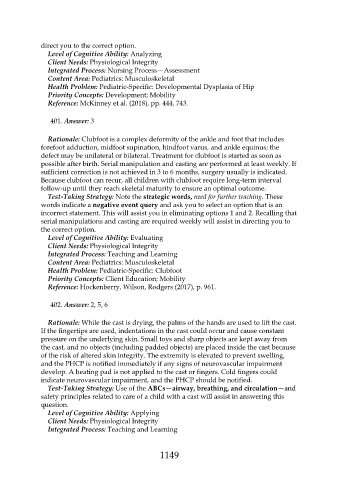Page 1149 - Saunders Comprehensive Review For NCLEX-RN
P. 1149
direct you to the correct option.
Level of Cognitive Ability: Analyzing
Client Needs: Physiological Integrity
Integrated Process: Nursing Process—Assessment
Content Area: Pediatrics: Musculoskeletal
Health Problem: Pediatric-Specific: Developmental Dysplasia of Hip
Priority Concepts: Development; Mobility
Reference: McKinney et al. (2018), pp. 444, 743.
401. Answer: 3
Rationale: Clubfoot is a complex deformity of the ankle and foot that includes
forefoot adduction, midfoot supination, hindfoot varus, and ankle equinus; the
defect may be unilateral or bilateral. Treatment for clubfoot is started as soon as
possible after birth. Serial manipulation and casting are performed at least weekly. If
sufficient correction is not achieved in 3 to 6 months, surgery usually is indicated.
Because clubfoot can recur, all children with clubfoot require long-term interval
follow-up until they reach skeletal maturity to ensure an optimal outcome.
Test-Taking Strategy: Note the strategic words, need for further teaching. These
words indicate a negative event query and ask you to select an option that is an
incorrect statement. This will assist you in eliminating options 1 and 2. Recalling that
serial manipulations and casting are required weekly will assist in directing you to
the correct option.
Level of Cognitive Ability: Evaluating
Client Needs: Physiological Integrity
Integrated Process: Teaching and Learning
Content Area: Pediatrics: Musculoskeletal
Health Problem: Pediatric-Specific: Clubfoot
Priority Concepts: Client Education; Mobility
Reference: Hockenberry, Wilson, Rodgers (2017), p. 961.
402. Answer: 2, 5, 6
Rationale: While the cast is drying, the palms of the hands are used to lift the cast.
If the fingertips are used, indentations in the cast could occur and cause constant
pressure on the underlying skin. Small toys and sharp objects are kept away from
the cast, and no objects (including padded objects) are placed inside the cast because
of the risk of altered skin integrity. The extremity is elevated to prevent swelling,
and the PHCP is notified immediately if any signs of neurovascular impairment
develop. A heating pad is not applied to the cast or fingers. Cold fingers could
indicate neurovascular impairment, and the PHCP should be notified.
Test-Taking Strategy: Use of the ABCs—airway, breathing, and circulation—and
safety principles related to care of a child with a cast will assist in answering this
question.
Level of Cognitive Ability: Applying
Client Needs: Physiological Integrity
Integrated Process: Teaching and Learning
1149

